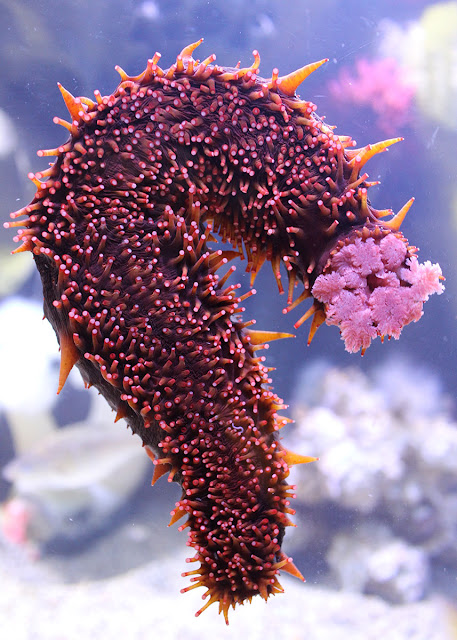 |
| Olympic Coast exhibit, can you spot any cucumbers? |
Let's take a pair of similar — and, perhaps, under-appreciated — residents from both exhibits and compare. Meet, the sea cucumbers! There are hundreds of species of sea cucumber, and the ones you find in our local waters have significant differences from ones you'll find along the Olympic Coast.
In this image you're looking at its undersides, which is a jumble of tube feet. These tube feet help this animal cling to surfaces and (slowly) navigate coastal habitats from Baja, Mexico, to mid-Alaska. Sea stars and urchins also have tube feet. The shock of pink at one end is its mouth surrounded modified tentacles that sift through sediment as it creeps along the seafloor — or along the crystalline glass of the new exhibit.
 |
| West Coast: Bristling tube feet |
 |
| West Coast: The soft spines on the back of the California sea cucumber |
Now to East Coast to meet the orange-footed sea cucumber (Cucumaria frondosa).
The East Coast sea cucumbers that you might find in the Stellwagen Bank National Marine Sanctuary feature five orderly rows of tube feet around their entire cylindrical body. They serve the same purpose: to get around and cling to surfaces. The feathery appendages are those modified tentacles on the mouth-end of the animal. Unlike their West Coast cousins that have downward-facing tentacles that graze along the seafloor, the tentacles of the orange-footed cucumbers are flayed out in the currents to ensnare passing plankton.
 |
| East Coast: Lines of tube feet on the undersides of these orange footed sea cucumbers |
 |
| East Coast: Orange footed cucumbers also have lines of tube feet on their back. This helps grab on to any surface, above or below. Also note the fringe of feeding tentacles. |
Sea cucumbers are not the only animals you'll encounter in our Northern Waters gallery. Hardly! Come visit and meet the giant Pacific octopus that inhabit the new Olympic Coast exhibit near the California sea cucumbers. Then saunter down to take a look at the goosefish and lobsters in the boulder reef of the Gulf of Maine exhibits. The Aquarium is a great place to explore our blue planet — from East Coast to West!
 |
| Aquarist Bill Murphy cradles California sea cucumbers as he transports them from their transport container to the new Olympic Coast exhibit. |










